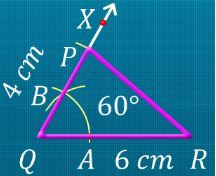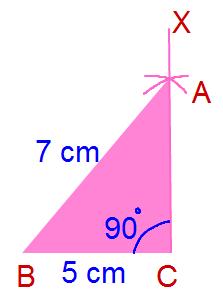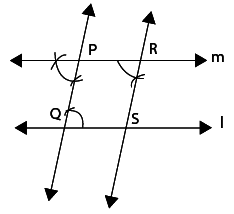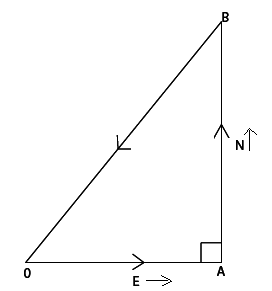7th Grade > Mathematics
PRACTICAL GEOMETRY MCQs
A man runs in the east direction and suddenly changes his direction towards the north. After running for some time, he comes back to his original position. Given that the man's path of running is a triangle and one of its angles is 90 degrees, find the sum of the other two angles. [3 MARKS]
:
Steps: 1 Mark
Construction: 1 Mark
Draw a line segment AB = 3 m and extend it.
Sum of two interior opposite angles is equal to the exterior angle.
∠BAC+∠ACB=120∘
Hence, ∠ABC=60∘
Hence, the given triangle is an equilateral triangle.
Draw AB = 3 m
Draw a line AC of length 3 m making an angle of 60 degrees with AB. Join BC.
:
Construction: 2 Marks
Steps: 2 Marks
Draw ¯¯¯¯¯¯¯¯PQ=3.5 cm
Construct ∠XPQ=120∘ with your compass.
With P as centre, draw an arc with radius equal to 3 cm that intersects ¯¯¯¯¯¯¯¯¯XP at point R.
Join ¯¯¯¯¯¯¯¯¯RQ
PQR is the required triangle.

Thus, we see that if two sides of a triangle are given and the measure of the angle between these two sides is also given, then we can construct a triangle. This is known as SAS criterion for construction of triangles.
:
Steps: 2 Marks
Construction: 1 Mark
Given that it is a right-angled triangle.
Sum of the squares of the two sides of the triangle is equal to the square of the hypotenuse
Let the length of the other side be X m
32+X2=52
X = 4
Draw a line segment AB = 3 m
Draw a line segment AC of length 4 m perpendicular to AB
Join BC.
:
Each part: 2 Marks
(a) Adding up the sides, taking two at a time, we get
9 m + 5 m = 14 m > 3 m
9 m + 3 m = 12 m > 5 m
but, 5 m + 3 m = 8 m < 9 m
So we see that the sum of one pair of sides when added is not greater than the third side.
Therefore, we cannot draw a triangle with these measurements.
(b) Adding up the sides, taking two at a time, we get
10 cm + 10 cm = 20 cm > 4 cm
10 cm + 4 cm = 14 cm > 10 cm
4 cm + 10 cm = 14 cm > 10 cm
So in each case, the sum of two sides is greater than the third side.
Hence, this triangle can be constructed.
:
Each part: 2 Marks
(a) Steps of construction:
Draw ¯¯¯¯¯¯¯¯PQ=3.5 cm
With P as the centre, draw an arc with the radius equal to 4.5 cm.
With Q as the centre, draw another arc with radius 5.5 cm to cut the previous arc at R.
Join R to P and Q.
PQR is the required triangle.

Thus, we see that if three sides of a triangle are given and the sum of any two sides is always more than the third side, then a triangle can be constructed. This is known as SSS criterion for construction of triangles.
(b) Steps of construction:
Step 1: Draw a line segment QR = 6 cm.
Step 2: Construct an angle of 60∘ at point Q.
Step 3: Draw an arc on the ray QX with Q as the centre and the radius equal to 4 cm.
Step 4: Name the point where the arc cuts the ray QX, as P.
Step 5: Join points P and R.
PQR is the required triangle.

:
Each part: 2 Marks
(a) Draw a line segment ¯¯¯¯¯¯¯¯BC=8 cm

Draw ∠CBD=90∘ at B using compass.
With C as centre and radius equal to 10 cm, draw an arc to cut the ray ¯¯¯¯¯¯¯¯¯BD at A and join ¯¯¯¯¯¯¯¯AC.
ABC is the required triangle.
(b) Steps of Construction:
(i) Draw BC = 5 cm.
(ii) Construct ∠BCX = 90∘.
(iii) With B as centre and radius 7 cm, cut BA at 7 cm.
(iv) Join AB.

Thus, ABC is the required triangle.
:
Construction: 2 Marks
Steps: 2 Marks
Step 1: Draw ¯¯¯¯¯¯¯¯PQ=4.5 cm
Step 2: Construct ∠XPQ=30∘ and ∠PQY=45∘
Step 3: Mark the point of intersection of ¯¯¯¯¯¯¯¯¯XP and ¯¯¯¯¯¯¯¯¯YQ as R.
PQR is the required triangle.

Thus, we see that if two angles of a triangle and the side included between the two are given, then we can draw a triangle. This is known as ASA criterion of construction of triangles.
:
Steps: 2 Marks
Construction: 2 Marks
To construct: A pair of parallel lines intersecting other parts of parallel lines.
Steps of construction:

Draw a line l and take a point P outside l.
Take point Q on line l and join PQ.
Make equal angle at point P such that ∠Q=∠P.
Extend line at P to get line m.
Similarly, taking a point R on line m, at point R, draw angles such that ∠P=∠R.
The extended line at R which intersects at S on line l, Draw line RS. Thus, we get a parallelogram PQRS.

















